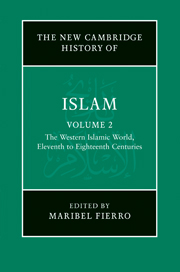Book contents
- Frontmatter
- Introduction
- PART I AL-ANDALUS AND NORTH AND WEST AFRICA (ELEVENTH TO FIFTEENTH CENTURIES)
- PART II EGYPT AND SYRIA (ELEVENTH CENTURY UNTIL THE OTTOMAN CONQUEST)
- PART III MUSLIM ANATOLIA AND THE OTTOMAN EMPIRE
- PART IV NORTH AND WEST AFRICA (SIXTEENTH TO EIGHTEENTH CENTURIES)
- PART V RULERS, SOLDIERS, PEASANTS, SCHOLARS AND TRADERS
- 19 State formation and organisation
- 20 Conversion to Islam: from the ‘age of conversions’ to the millet system
- 21 Taxation and armies
- 22 Trade
- 23 The ʿulamāʾ
- Glossary
- Bibliography
- Index
- References
19 - State formation and organisation
from PART V - RULERS, SOLDIERS, PEASANTS, SCHOLARS AND TRADERS
Published online by Cambridge University Press: 28 March 2011
- Frontmatter
- Introduction
- PART I AL-ANDALUS AND NORTH AND WEST AFRICA (ELEVENTH TO FIFTEENTH CENTURIES)
- PART II EGYPT AND SYRIA (ELEVENTH CENTURY UNTIL THE OTTOMAN CONQUEST)
- PART III MUSLIM ANATOLIA AND THE OTTOMAN EMPIRE
- PART IV NORTH AND WEST AFRICA (SIXTEENTH TO EIGHTEENTH CENTURIES)
- PART V RULERS, SOLDIERS, PEASANTS, SCHOLARS AND TRADERS
- 19 State formation and organisation
- 20 Conversion to Islam: from the ‘age of conversions’ to the millet system
- 21 Taxation and armies
- 22 Trade
- 23 The ʿulamāʾ
- Glossary
- Bibliography
- Index
- References
Summary
Historiography: three types of government
All societies have government in the sense of rules of behaviour, but not all societies have a government to make and enforce those rules. The medieval world of the Mediterranean had inherited a long tradition of such government, beginning with the magistracies of the ancient city-states and culminating in the monarchies of the Roman and Byzantine empires. These, however, overlay a still longer tradition of customary self-regulation by peoples of the mountains, deserts and forests within and without the Roman frontiers, which had revived as the frontier was overrun by these barbarians, and imperial government shrank away towards the east. The tradition of imperial government was renewed by the Arabs, the last of the barbarians as well as the last of the heretics, who carried it back to North Africa and the Iberian Peninsula, as well as to Central Asia and northern India, without suppressing the tradition of self-government among the peoples of the mountains and the deserts whom they brought under their sway. The subsequent history of state formation and organisation in the lands of the Arab empire is a history of the working out of the opposition between these two kinds of government under the rubric of their faith, with its requirement for government in accordance with the Law of God.
- Type
- Chapter
- Information
- The New Cambridge History of Islam , pp. 547 - 585Publisher: Cambridge University PressPrint publication year: 2010
References
- 1
- Cited by

